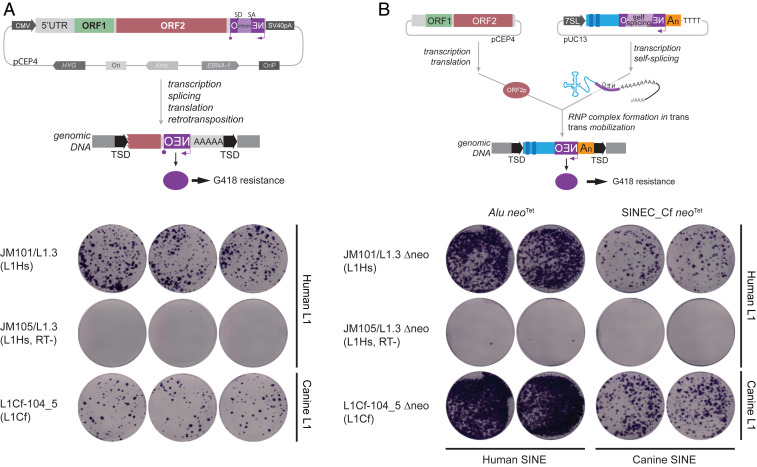Fig. 5.
Identification of canine LINE-1 and SINEC elements capable of retrotransposition. (A) Top) A full-length L1_Cf equipped with a retrotransposition indicator cassette (mneoI) was assayed for retrotransposition in human HeLa-HA cells. TSD indicates a target site duplication generated upon retrotransposition. (Bottom) Results of the retrotransposition assay. JM101/L1.3 (positive control) contains an active human LINE-1. JM105/L1.3 (negative control) contains a human LINE-1 that harbors an inactivating missense mutation in the reverse transcriptase domain of ORF2p (99). ADL1Cf-104_5 contains the full-length canine LINE-1 identified in this study. (B) (Top) A consensus SINEC_Cf element equipped with an indicator cassette to monitor the retrotransposition of RNA pol III transcripts (neotet) (75) was assayed for retrotransposition in human HeLa-HA cells in the presence of either an active human LINE-1 or the newly cloned L1_Cf-104_5 sequence that lacks a retrotransposition indicator cassette (JM101/L1.3Δneo or ADL1Cf-104_5Δneo, respectively). (Bottom) Results of the retrotransposition assay. JM101/L1.3Δneo (positive control) contains an active human LINE-1. JM105/L1.3 Δneo (negative control) contains a human LINE-1 that harbors an inactivating missense mutation in the reverse transcriptase domain of ORF2p (99). ADL1Cf-104_5Δneo contains an active canine LINE-1 (see A). The expression of either JM101/L1.3Δneo or ADL1-Cf-105Δneo could drive human Alu and canine SINEC_Cf retrotransposition. In both assays, the blue-stained foci represent G418-resistant foci containing a presumptive retrotransposition event. See SI Appendix, section 6 for additional details.

